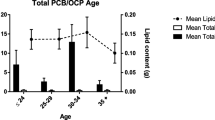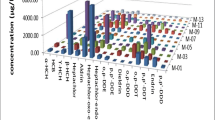Abstract.
Persistent chlorinated hydrocarbons assimilated through the diet may, as a result of their carcinogenic, immunotoxic, and, at least in regard to certain of these substances, estrogenic properties, play a role in the etiology of human breast cancer. As a consequence, increased concentrations of these ubiquitous environmental contaminants may be found in breast tissue of women suffering from malignant breast disease. To examine this possibility, surgically removed breast tissue samples from 65 women in Hesse, Germany were examined by capillary gas chromatography for p,p′-dichloro(diphenyl)trichloroethane (p,p′-DDT), p,p′-dichloro(diphenyl)-dichloroethane (p,p′-DDD), p,p′-dichloro(diphenyl)dichloroethene (p,p′-DDE), hexachlorobenzine (HCB), α-, β-, and γ-hexachlorocyclohexane (HCH) as well as the polychlorinated biphenyls (PCB) no. 28, 31, 49, 52, 101, 105, 118, 138, 153, 156, 170, and 180. Of the 65 patients, 45 were diagnosed with breast cancer. The control group of 20 women suffered from benign breast disease such as mastopathy. After statistical adjustment for age differences, higher concentrations of p,p′-DDT, p,p′-DDE, HCB as well as PCB-congeners no. 118, 138, 153, and 180 were detected in tissue from women with breast cancer than in tissue from control persons. These differences were weakly significant for p,p′-DDE (p = 0.017), for PCB 118 (p = 0.042) and for PCB no. 153 barely not significant (p = 0.083). On an average, a 62% higher concentration of p,p′-DDE was found in cancer tissue (cancer patients: 805 μg/kg fat; controls: 496 μg/kg fat) and 25% higher concentration of PCB no. 118 (81 μg/kg fat; 65 μg/kg fat). The concentrations of β-HCH, PCB no. 156 and 170 were lower (not significant) in cancer tissue than in tissue from women with benign disease. PCB-congeners no. 105 and 149 as well as γ-HCH could only be detected in individual tissue samples; congeners no. 28, 31, 49, 52, and 101 as well as α-HCH and p,p′-DDD were not detected in any of the samples. To rule out the possibility that the concentrations of chlorinated hydrocarbons measured were influenced by the surgical procedure, 20 samples of tissue that were at a distance (minimum 1 cm and maximum 3 cm) from the tumor, tissue that was in direct proximity to the tumor (no more than 5 mm from the tumor), and tumor tissue itself (center of tumor) were separately prepared and analyzed. The average concentrations of chlorinated hydrocarbons varied to differing degrees and only minimally in tumor and surrounding breast tissue, indicating that the surgical procedure did not influence the results.
Similar content being viewed by others
Author information
Authors and Affiliations
Additional information
Received: 30 September 1997/Accepted: 6 January 1998
Rights and permissions
About this article
Cite this article
Güttes, S., Failing, K., Neumann, K. et al. Chlororganic Pesticides and Polychlorinated Biphenyls in Breast Tissue of Women with Benign and Malignant Breast Disease. Arch. Environ. Contam. Toxicol. 35, 140–147 (1998). https://doi.org/10.1007/s002449900361
Issue Date:
DOI: https://doi.org/10.1007/s002449900361




